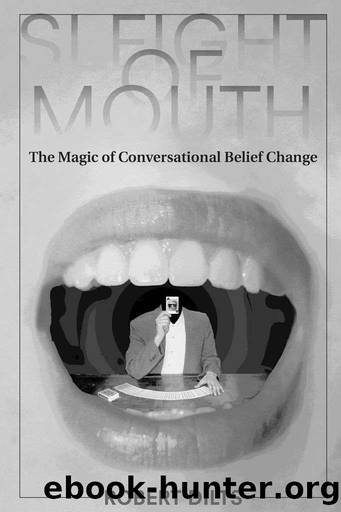Sleight of Mouth: The Magic of Conversational Belief Change by Robert Robert Dilts

Author:Robert Robert Dilts [Dilts, Robert Robert]
Language: eng
Format: azw3
Publisher: Dilts Strategy Group
Published: 2017-10-15T00:00:00+00:00
Beliefs Connect Values to Various Aspects of Our Experience
In order for a particular value to become operational, this entire system of beliefs must be specified to some degree. For a value such as âprofessionalismâ to be enacted behaviorally, for example, one must build beliefs about what professionalism is (the âcriteriaâ for professionalism); how you know it is being enacted (the âcriterial equivalencesâ); what causes it; and what it leads to. These beliefs are as significant as the value itself in determining how people will act.
Two people can share the same value of âsafety,â for example. One person, however, may believe that safety is caused by âbeing stronger than oneâs enemies.â The other person may believe that safety is caused by âunderstanding and responding to the positive intentions of those who threaten us.â These two will seek safety in quite different ways. Their approaches may even appear to contradict one another. The first one will seek safety by building power (having âa bigger stickâ than those he or she perceives as an âenemyâ). The other will seek safety through communication, gathering information and looking for options.
Clearly, an individualâs beliefs relating to his or her core values will determine the personâs âmental mapâ with respect to those values; and thus, how the person attempts to manifest those values. In order to adequately teach or establish values, all of these belief issues must be appropriately addressed. For people in a system to act coherently with core values, they must all share certain beliefs, as well as values, to some degree.
Sleight of Mouth patterns can be viewed as verbal operations that shift or reframe the various elements and linkages which make up the complex equivalences and cause-effects which form beliefs and belief statements. All Sleight of Mouth patterns revolve around using language in order to relate and link various aspects of our experience and maps of the world to core values.
In the model of Sleight of Mouth, a complete âbelief statementâ must minimally contain either a complex equivalence or cause-effect assertion. A verbalization such as, âPeople donât care about me,â for instance, is not yet a full âbelief statementâ. It is a generalization related to the value of âcaringâ; but does not yet reveal the beliefs associated with the generalization. To elicit the beliefs related to this generalization, one would need to ask, âHow do you know that people donât care about you?â âWhat makes people not care about you?â âWhat are the consequences of people not caring about you?â and âWhat does it mean that people donât care about you?â
Such beliefs are often elicited through âconnectiveâ words, such as: âbecause,â âwhenever,â âif,â âafter,â âtherefore,â etc. - i.e., âPeople donât care about me because. . .â âPeople donât care about me if. . .â âPeople donât care about me therefore. . .â
Again, from the NLP perspective, the issue is not so much whether one has found the âcorrectâ cause-effect belief, but rather what types of practical results one is able to achieve if one acts âas ifâ a particular equivalence or causal relationship exists.
Download
This site does not store any files on its server. We only index and link to content provided by other sites. Please contact the content providers to delete copyright contents if any and email us, we'll remove relevant links or contents immediately.
We Need to Talk by Celeste Headlee(4862)
Pre-Suasion: A Revolutionary Way to Influence and Persuade by Robert Cialdini(3404)
Captivate by Vanessa Van Edwards(3292)
I Love You But I Don't Trust You by Mira Kirshenbaum(3224)
Goodbye Paradise(2949)
How to win friends and influence people by Dale Carnegie(2819)
How to Win Friends and Influence People in the Digital Age by Dale Carnegie & Associates(2814)
The Hard Questions by Susan Piver(2549)
Fluent Forever: How to Learn Any Language Fast and Never Forget It by Gabriel Wyner(2442)
The Dictionary of Body Language by Joe Navarro(2426)
Surrounded by Idiots by Thomas Erikson(2327)
The Story Factor: Inspiration, Influence, and Persuasion through the Art of Storytelling by Annette Simmons(2243)
Just Listen by Sarah Dessen(2177)
How to Be Yourself by Ellen Hendriksen(1933)
The Power of Moments by Chip Heath & Dan Heath(1888)
Behave: The Biology of Humans at Our Best and Worst by Robert M. Sapolsky(1817)
How to Make Small Talk by Melissa Wadsworth(1796)
Not Nice: Stop People Pleasing, Staying Silent, & Feeling Guilty... And Start Speaking Up, Saying No, Asking Boldly, And Unapologetically Being Yourself by Dr Aziz Gazipura PsyD(1752)
The Small BIG Small Changes that Spark Big Influence by Steve Martin & Noah Goldstein & Robert Cialdini(1534)
